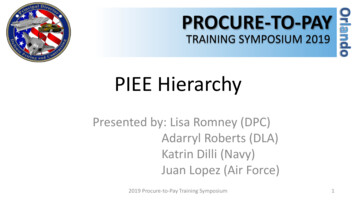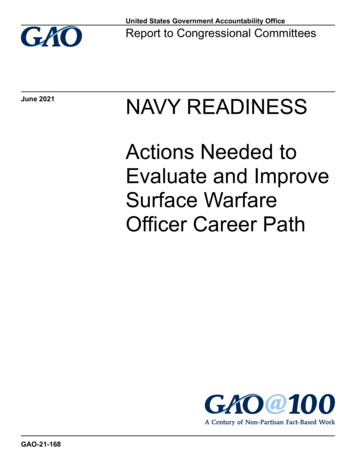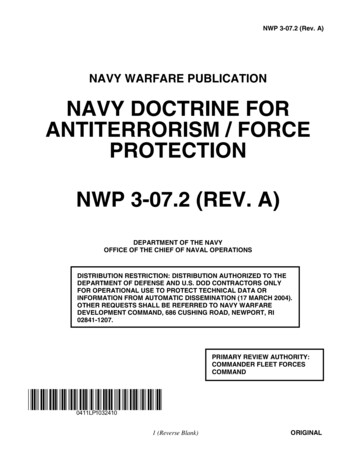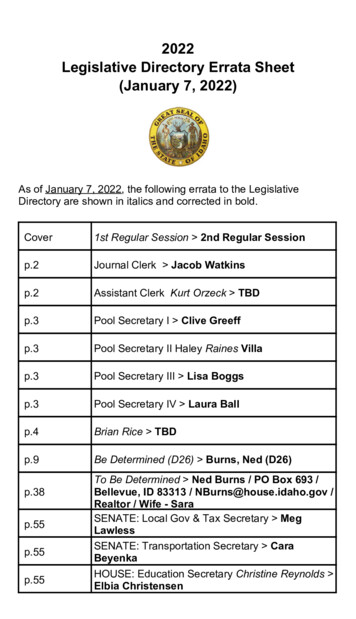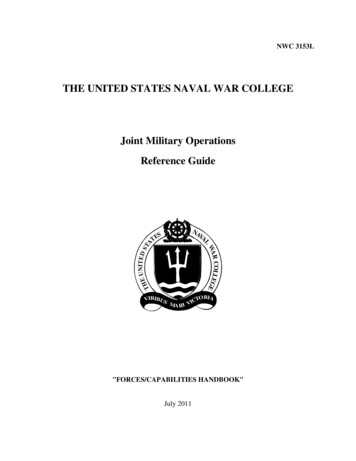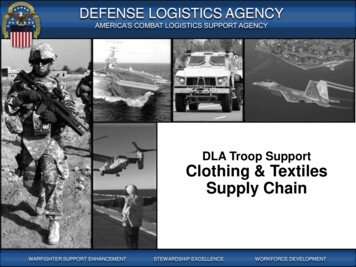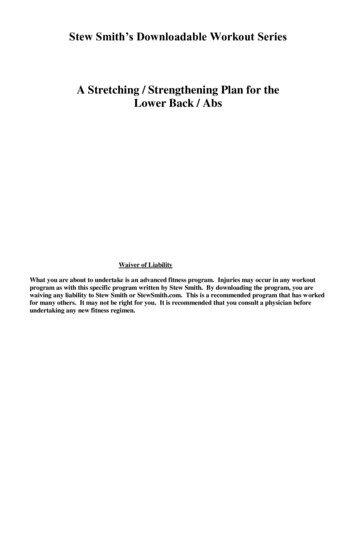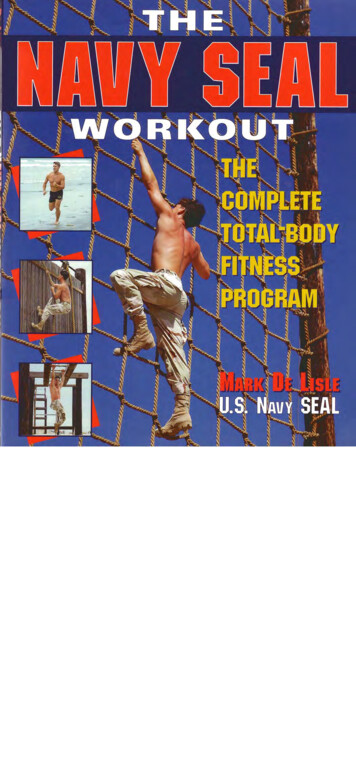
Transcription
T H E S E CR E TA RY O F T H E NAVYSECNAV M-5216.5March 2010Department of the NavyCorrespondenceManualPublished ByT HE S ECR ET A R Y O F T HE NA V Y
SECNAV Manual M-5216.5March 2010FOREWORDThis manual is issued to prescribe uniform standards for the management and preparation ofcorrespondence and is applicable to all commands and activities of the Department of the Navy.The following directives and manuals are cancelled:SECNAVINST 5216.5D of 29 Aug 96Secretary of the Navy Writing Guide 14 Apr 06Local supplements to amplify this manual may be issued and inserted as chapter 13. A localsupplement shall not contradict or repeat information contained in this manual.Forward recommended changes to this manual to:OFFICE OF THE SECRETARY OF THE NAVYDIRECTOR OF ADMINISTRATION1000 NAVY PENTAGON ROOM 4D652WASHINGTON DC 20350-1000Copies of this manual may be obtained through normal publications channels, Department of theNavy Issuances Web site; or from the Marine Corps Publications Electronic Library Online Website. This manual is approved for authorized registered users and distribution is unlimited.Authorized registered users may obtain copies of the publications from:UNDER SECRETARY OF THE NAVYPUBLICATIONS MANAGEMENT BRANCH1000 NAVY PENTAGON ROOM 5D773WASHINGTON DC 20350-1000Robert O. WorkUnder Secretary of the Navyi
SECNAV Manual M-5216.5March 2010THIS PAGE INTENTIONALLY LEFT BLANKii
SECNAV Manual M-5216.5March 2010TABLE OF CONTENTSTITLEPAGEFOREWORDiTABLE OF CONTENTSiiiREFERENCESixCHAPTER 1 – CORRESPONDENCE MANAGEMENT1-1 – Objective and Responsibilities1Objective2ResponsibilitiesCHAPTER 2 – CORRESPONDENCE STANDARDS AND PROCEDURES2-1 – Correspondence Standards and Procedures1General2North Atlantic Treaty Organization (NATO)2-2 – Procedures1Correspond Through Channels2Take Advantage of Correspondence Shortcuts3Coordination4Submit Finished Products for Signature5Signature Authority6Signature Stamps7Incoming Correspondence Controls8Replies to Correspondence9Outgoing Correspondence Controls10Limit Use of Social Security Numbers (SSN)11Identifying Navy and Marine Corps Personnel12Letterhead Stationery13Enclosures14Copies15Expressing Military Time16Expressing Dates17Abbreviations and Acronyms18Punctuating, Capitalizing, Spelling, Hyphenating, and SeparatingWords19Proofreading20Typeface21Color of 62-72-72-72-82-92-102-112-112-112-122-132-132-13
SECNAV Manual M-5216.5March 2010TITLECHAPTER 3 - ELECTRONIC RECORDS3-1 - General3-2 - sitionPAGE3-13-13-13-23-23-3CHAPTER 4 - ELECTRONIC MAIL4-1 - General4-2 - Procedures1Managing E-Mail2Formal Correspondence3Informal Correspondence4Security and Privacy Issues5Records Management6Digital Signatures4-14-14-14-14-24-24-24-2CHAPTER 5 - FACSIMILE TRANSMISSION SERVICES5-1 - General5-2 - Procedures1Managing Facsimile Services2Security and Privacy Issues3Records Management5-15-15-15-15-2CHAPTER 6 – POSTAL STANDARDS6-1 - General6-2 - Procedures1Choosing the Right Size Envelope or Container2Sources of Address Information3Delivery and Return Address Formats4Mail Classifications5Mail MarkingsFigure 6-1Folding TechniquesFigure 6-2Standard Address AbbreviationsFigure 6-3State/Territory AbbreviationsFigure 6-4Envelope Addressing Standards6-16-16-16-16-26-36-36-46-56-66-7CHAPTER 7 – CORRESPONDENCE FORMAT7-1 - Requirements7-2 - Format1Margins2Sender’s Symbols3Classified Correspondence4For Official Use Only7-17-17-17-17-27-3iv
SECNAV Manual M-5216.5March 2010TITLE56789101112131415161718Figure 7-1Figure 7-2Figure 7-3Figure 7-4Figure 7-5Figure 7-6Figure 7-7Figure 7-8Figure 7-9Figure 7-10“From:” Line“To:” Line“Via:” LineSubject LineReference LineEnclosure LineTextParagraphsSignature Line“Copy To:” LineIdentifying Second and Later PagesPage NumberingCorrespondence Package AssemblyTabbing a Correspondence PackageStandard Letter – First PageStandard Letter – Second PageStandard Letter – Window – EnvelopeJoint LetterStandard Letter with Classification Markings – First PageStandard Letter with Classification Markings – Second PageStandard Letter with FOUO MarkingsParagraph Structure FormatAssembly of a Standard Correspondence Package Using StackingMethodTabbing Correspondence -25CHAPTER 8 – MULTIPLE-ADDRESS LETTER8-1 - General8-2 - Listing Addressees1Using a “To:” Line Only2Using a “Distribution:” Line Only3Using Both a “To:” Line and “Distribution:” Line8-3 - Preparing and Signing Copies8-4 - Assembly of Multiple-Address LettersFigure 8-1Multiple-Address Letter Using “To: LineFigure 8-2Multiple-Address Letter Using “Distribution:” LineFigure 8-3Multiple-Address Letter Using a “To:” and “Distribution:” LineFigure 8-4Assembly of a Multiple-Address Letter8-18-18-18-18-18-18-18-28-38-48-5CHAPTER 9 – ENDORSEMENTS9-1 - General9-2 - Format1Endorsement Line2“Via:” Line3Adding References9-19-19-19-19-1v
SECNAV Manual M-5216.5March 2010TITLE4567Figure 9-1Figure 9-2Adding Enclosures“Copy To:” AddresseesForwarding Your Endorsement and CopiesAssembly of an EndorsementNew Page EndorsementAssembly of an EndorsementPAGE9-19-29-29-29-39-4CHAPTER 10 – MEMORANDUMS10-1 - General10-2 - Formats1Memorandum For The Record2From-To Memorandum3Plain-Paper Memorandum4Letterhead Memorandum5Decision Memorandum6Memorandum of Agreement or Memorandum of UnderstandingFigure 10-1Memorandum For The RecordFigure 10-2Printed “From-To” MemorandumFigure 10-3Plain-Paper MemorandumFigure 10-4Letterhead MemorandumFigure 10-5Memorandum of AgreementFigure 10-6Memorandum of Understanding – First PageFigure 10-7Memorandum of Understanding – Second -610-710-810-9CHAPTER 11 – BUSINESS LETTERS11-1 - General11-2 - Parts of a Business Letter and Format1Identification Symbols2Inside Address3Attention Line4Salutation Line5Subject Line6Body of the Letter7References and Enclosures8Complimentary Close9Signature Line10Enclosure Line11Separate Mailing12“Copy To:” Line13Outgoing Copies14Identifying Second and Succeeding Pages15Numbering PagesFigure 11-1Business Letter Paragraph FormatsFigure 11-2Business Letter – First PageFigure 11-3Business Letter – Second -311-311-411-411-411-411-511-611-7vi
SECNAV Manual M-5216.5March 2010TITLEFigure 11-4Figure 11-5Figure 11-6Business Letter For Window EnvelopesBusiness Letter With An “Attention” LineShort Business LetterCHAPTER 12 - EXECUTIVE CORRESPONDENCE12-1 - General12-2 - Processes1Correspondence Management2Assigning Action to Incoming Correspondence3Routing Changes4Due Dates5Extensions6Interim7Distribution12-3 - General Guidelines for Preparing a Letter1Stationery2Format3Date Line4Complimentary Closing5Page Numbering6Congressional Committees or Subcommittees Correspondence12 -4 - General Guidelines for Preparing a Memorandum1Action or Information Memorandums2Package AssemblyFigure 12-1SD Form 391 – DoD Correspondence Action ReportFigure 12-2Sample Interim Response to Incoming CorrespondenceFigure 12-3Sample Interim Response for Congressional CorrespondenceFigure 12-4Congressional Response, One ChairpersonFigure 12-5Congressional Response, Two ChairpersonsFigure 12-6Congressional Response, to a Chairman of a Select CommitteeFigure 12-7Flag Stationery (8 ½ x 11), Secretary of the NavyFigure 12-8Flag Stationery (5x7), Chief of Naval OperationsFigure 12-9Action MemorandumFigure 12-10 Information MemorandumFigure 12-11 Coordination PageFigure 12-12 Standard Memorandum ForAPPENDIX A – Military Models of AddressAPPENDIX B – Civilian Models of AddressAPPENDIX C – Stationary RequirementsAPPENDIX D – Forms and EnvelopsAPPENDIX E – 1912-20A-1B-1C-1D-1E-1vii
SECNAV Manual M-5216.5March 2010THIS PAGE INTENTIONALLY LEFT BLANKviii
SECNAV Manual M-5216.5March 2010REFERENCESREFERENCETITLENATO StandardizationAgreement (STANAG)Number 2066SNDL (OPNAVNOTE 5400)MCO 5216.19SECNAVINST 5730.5JFormat and Abbreviations in NATO Standardization AgreementEO 9397MCO 5215.1KGPO Style ManualSECNAV M-5210.1SECNAV M-5210.2SECNAV M-5510.36SECNAVINST 5720.42F5 U.S.C. §552a28 U.S.C. §1074SECNAVINST 5000.37SECNAVINST 5239.3BUSD P&R MemoOPNAVINST 5218.7BDoD Manual 4000.25-6-MSECNAVINST 5211.5ESECNAVINST 5430.7QMCO P5600.31GStandard Navy Distribution ListAdministration Action (AA) Form (NAVMC 10274, Rev. 3-86)Mission, Function, and Responsibilities of the Office ofLegislative Affairs and Procedures for Handling LegislativeAffairs and Congressional RelationsExecutive Order 9397Marine Corps Directives Management ProgramU.S. Government Printing Office Style ManualDepartment of the Navy Records Management ProgramDepartment of the Navy Standard Subject Identification Code(SSIC) ManualDepartment of the Navy Information Security Program ManualDepartment of the Navy Freedom of Information Act (FOIA)Privacy Act of 1974Federal Rules of EvidenceProvision of the Department of the Navy Documentary MaterialDepartment of the Navy Information Assurance PolicyPolicy for Digital Signature Functionality and Acceptance, of 12December 2006Navy Official Mail Management InstructionsDepartment of Defense Activity Address Directory (DoDAAD)Department of the Navy Privacy Act (PA) ProgramAssignment of Responsibilities and Authorities in the Office ofthe Secretary of the NavyMarine Corps Publications and Printing Regulationsix
SECNAV Manual M-5216.5March 2010THIS PAGE INTENTIONALLY LEFT BLANKx
SECNAV Manual M-5216.5March 2010CHAPTER 1Correspondence Management1-1 Objective and Responsibilities1. Objective. To prescribe uniform standards for the management and preparation ofcorrespondence throughout the Department of the Navy (DON).2.Responsibilitiesa. The Secretary of the Navy (SECNAV) will administer the DON CorrespondenceManagement Program and coordinate proposed changes to this manual with the Chief of NavalOperations (CNO) and the Commandant of the Marine Corps (CMC).b. CNO and CMC will administer the Correspondence Management Program within theNavy and Marine Corps, respectively.c. Commanding Officers and Heads of Activities will establish a correspondencemanagement program based on the requirements and guidance of this manual and ensure that:(1) Correspondence is screened, controlled, reviewed, and answered accordingly.(2) Correspondence practices are reviewed periodically to improve products andprocedures.(3) The most economical communications media and techniques available are used.(4) Only essential correspondence is produced.d.Administration Officers will:(1) Screen incoming correspondence, assign action offices and due dates, and indicateany required concurrences.(2) Review outgoing correspondence for correct format and ensure prescribedprocedures are followed.1-1
SECNAV Manual M-5216.5March 2010THIS PAGE INTENTIONALLY LEFT BLANK1-2
SECNAV Manual M-5216.5March 2010CHAPTER 2Correspondence Standards and Procedures2-1 Correspondence Standards1. General. To a large degree, the image and effectiveness of the DON is portrayed by the tone,quality, and responsiveness of correspondence. Properly written correspondence that clearly andsuccinctly establishes a position, correctly and completely answers questions, and conveys theright message, all aid in the effective management and operation of the DON. In order toachieve this, correspondence must:a. Be neat in appearance, correctly formatted, error free, and grammatically correct. Withthe use of computers and advanced word processing software, the long-accepted practice ofallowing legible “pen and ink” changes to a piece of correspondence is no longer acceptable. Allcorrespondence shall be free of typographical errors and technically correct before it is signed.b. Avoid stereotyping men and women based on gender. Use pronouns and titles that aregender neutral.c. Do not write unless you must. A conversation in person, by telephone, or by electronicmail (e-mail) often saves two letters - the one you would have written and the other person’sresponse. Conversations are often better than correspondence for working out details. Confirmyour conversation with a short memorandum (also referred to as “memo”) to the other person ora “Memorandum For The Record” if issues of importance or policy are agreed upon during theconversation.d. Always include a point of contact, return telephone number, and e-mail address whenyour correspondence might prompt a reply or inquiry.2. North Atlantic Treaty Organization (NATO). When writing to other NATO Forces use theformat and abbreviations in NATO Standardization Agreement (STANAG) Number 2066,Layout for Military Correspondence. STANAG Number 2066 is stocked by the Naval AviationSupply Office (ASO), 5801 Tabor Avenue, Philadelphia, PA 19120-5099.2-2 Procedures1.Correspondence through Channelsa. Use the Chain of Command. Follow your chain of command when corresponding onsubstantive matters such as command decisions, policy issues, and official recommendations.(1) Address communications directly to the top official of the organization concernedby title. Show the action office by including the code or person’s title in parenthesesimmediately after the activity’s name.2-1
SECNAV Manual M-5216.5March 2010(2) Address correspondence concerning policy, management decisions, or otherimportant matters via the chain of command or those commands, activities, or offices who havecognizance over the subject matter. This keeps intermediate commands informed and allowsthem to comment or approve as necessary.(3) A “Via” addressee will always forward official correspondence with anendorsement. The endorsement may be as simple as using the term “forwarded” when noopinion or comment is needed. A “Via” addressee may elect to take final action, divert therouting, or return the correspondence to the originator with appropriate explanation (chapter 9).(4) When there is no time to send important correspondence “Via” the chain ofcommand and still meet a deadline, you may:(a) Send correspondence via the chain of command, with an advance copy to the“To” addressee. To alert all addressees to this unusual routing, repeat the action addressee byStandard Navy Distribution List (SNDL) short title in a “Copy to:” line and include the term“(advance)” after the short title.EXAMPLE:Copy to:CNO (advance)JAG(b) Send correspondence directly to the “To” addressee with a concurrent copy toeach intermediate addressee. Include in the text a statement like this: “A copy of thiscorrespondence has been mailed directly to all addressees. Request “Via” addressees forwardyour endorsements directly to.” Additionally, include the “Via” addressees by SNDL shorttitles in the “Copy to:” line.b.Variations to Corresponding Through the Chain of Command(1) Authorized subordinates of different activities may correspond directly with eachother on routine matters.(2) List any cognizant addressees in the “Via:” line when it is determined that theyshould see a letter before it reaches the “to” addressee.(3) Include intermediate commands as “Copy to” addressees instead of “Via”addressees if you want them to see certain routine correspondence without having to endorse it.(4) Bypass intermediate commands that clearly have no interest in a letter’s contentand no requirement to comment or act.2-2
SECNAV Manual M-5216.5March 2010c.Individuals Writing to Higher Authority(1) Navy Personnel. When writing to higher authority on a personal matter affectingthe command, prepare your letter on plain bond paper in standard letter format. Examplesinclude requests for retirement or resignation. Address the letter to the higher authority and sendit “Via” your chain of command. Each “Via” addressee will prepare an endorsement andforward the correspondence to the next addressee.(2) Marine Corps Personnel. Use NAVMC 10274, Administrative Action (AA) Form,as prescribed in Marine Corps Order 5216.19 (MCO 5216.19).2.Take Advantage of Correspondence Shortcutsa. Facsimile Machines. Facsimile machines provide a fast and reliable means for sendingofficial correspondence (chapter 5).b. E-mail. You can use e-mail for formal and informal correspondence. See chapter 4 foradditional information.c. Window Envelopes. Window envelopes eliminate the cost of addressing envelopes andthe risk of putting letters in the wrong envelopes. To format letters for use with windowenvelopes see page 7-18. It should be noted that the window-envelope letter format has no“From:” line, so every copy that goes outside your activity must be on letterhead to show itsorigin. Do not use a window envelope for material that:(1) Is classified.(2) Involves national security.(3) Is of a personal nature.(4) Is sent to high-level officials.d. Form and Guide Letters. Periodically review correspondence for recurring, routinetopics that can be addressed with a standard response. This standard response can be developedinto a form or format letter to save time. See “Form and Guide Letters, an InformationResources Management Handbook by the General Services Administration (GSA).” Thishandbook is available through the Military Standard Requisitioning and Issue Procedures(MILSTRIP) system.(1) Use form letters when possible for routine matters that require no personal touch.Avoid form letters when expressing sympathy, apology, or appreciation.2-3
SECNAV Manual M-5216.5March 2010(2) Guide letters are pre-drafted standard letters that contain paragraphs that you maypick from to best fit the situation for which you are writing. Type or print them individually sothey seem personally composed.3. Coordination. Coordination is a critical step in the processing of outgoing correspondence.In order to ensure that a proper response or original letter is prepared, the originator will need todecide who needs to concur before the letter is signed. The originator will obtain appropriateconcurrences, resolve major differences, and arrange for any needed retyping.a. Always coordinate during the drafting stage, before the correspondence is put into finalform and submitted for signature. Ensure all coordination inputs are retained and filed with thefile copy of the signed correspondence.b. Limit reviews to only those offices that have a substantial interest in the topic of thecorrespondence.c. In some cases, coordination can be done quickly and informally. Discussions by phoneor in person or coordination via e-mail are often more efficient than formal written coordination,especially if a letter is brief and routine.4. Submit Finished Products for Signature. Normally, submit correspondence for signature infinal form. Use double-spaced drafts only when changes are likely, perhaps because a subject iscontroversial or a policy statement needs precise wording. Early guidance to writers about asigner’s preferences will reduce the frequency of changes.5.Signature Authority. Delegate signature authority to the lowest legal and practical level.a. What the Commander/Commanding Officer/Officer in Charge Must Sign. Thecommander/commanding officer/officer in charge must personally sign documents that:(1) Establish policy.(2) Center on the command’s mission or efficiency and are addressed to higherauthority.(3) Deal with certain aspects of military justice.(4) Are required by law or regulation.b.Delegation of Signature Authority(1) Delegation of signature authority may be made to military and civilian subordinates.All delegations of signature authority will be made in writing and signed by the persondelegating the authority. If the delegation of authority is provided for in a directive, indicate thisdelegation in a generic reference to a billet or position title. For each individual that thedelegation of authority applies, a letter so delegating that authority to the individual, by name,2-4
SECNAV Manual M-5216.5March 2010will be prepared. Include a brief outline of the scope of delegation, and if appropriate, authorizethe individual to further delegate or sub-delegate the authority. In the absence of specific subdelegation guidance, delegated signature authority shall not be sub-delegated.(2) An individual who signs correspondence under delegated authority will use theterm “By direction” typed below their name when signing documents under this delegatedauthority.EXAMPLE:I. M. FRUSTERBy directionc. Acting for the Commander/Commanding Officer/Officer in Charge. In the absence ofthe commander/commanding officer/officer in charge, and where specifically authorized by lawor regulation, an officer who temporarily succeeds to command shall sign officialcorrespondence with the term “Acting” typed below their name.EXAMPLE:J. CANNONActingd. Acting for an Official Who Signs by Title. When the signatory has been formally, buttemporarily, appointed to replace an official who signs correspondence by title rather than “Bydirection,” the word “Acting” is typed below the typed name.EXAMPLE:J. IVESDeputyActinge. Signing “For” an Absent Official. When a piece of correspondence is in final form andthe official that would normally sign the correspondence is unable to do so, it is permissible tohave the correspondence signed “for.” Rather than modifying the document to replace thesignature line, an individual already delegated signature authority may sign the correspondenceand hand write the term “for” before the typed name of the regular signing official. This methodshould be used only when a delay would fail to meet a crucial deadline.6. Signature Stamps/Electronic Signatures. Commanders/commanding officers/officers incharge or civilian equivalents may authorize the use of a signature stamp or an electronicsignature that replicates his or her signature where personal signing of a piece of correspondenceis impractical or the correspondence is of a routine nature. Personnel authorized to use asignature stamp of someone else’s signature shall pen their initials next to each signature theystamp to authenticate the stamp. Safeguard signature stamps from unauthorized use.7. Incoming Correspondence Controls. Controlled correspondence is correspondence thatrequires some type of action, requires a response, or has long-term reference value.a. Date Stamp. Date stamp all incoming controlled correspondence on the day it arrives atthe command. It is a good practice to date stamp all incoming correspondence, not justcontrolled correspondence.2-5
SECNAV Manual M-5216.5March 2010b. Restrict Assignment of Controls. Assign controls to only incoming mail that requires aresponse or has long-term reference value. Incoming action correspondence should be routeddirectly from the correspondence management office to the action office. If necessary, sendduplicate copies to intermediate or coordinating offices.c. Track Correspondence. Use OPNAV 5211/7 Correspondence/Document Control Cardto track the status of controlled correspondence routed for action.8.Replies to Correspondencea. Controlled Correspondence. Take prompt action on incoming correspondence thatrequires action or a response. Normally, correspondence should be answered within 10 workingdays or as prescribed by the immediate superior in command or by the tasking authority for theresponse.b.Congressional Correspondence(1) Reply directly to members of Congress if they contact your activity on routine andnon-policy matters. When doubt exists over whether to release certain information, contact theOffice of Legislative Affairs for guidance.(2) Correspondence from Congress shall be answered within 5 workdays of receipt. Ifa response cannot be provided within 5 days, send an interim response that acknowledges receiptof the correspondence and provides an estimated date when a final response will be sent. Sendthe original response plus an additional copy when responding to a Congressional inquiry. Also,send a blind copy of your final reply and substantive interim replies to:CHIEF OF LEGISLATIVE AFFAIRSNAVY DEPARTMENTWASHINGTON DC 20350-1000(3) The opening line in the text of the response should read, “Thank you for your letterof [date], concerning [issue].” NOTE: The date format is month day, year (i.e., June 19, 2009).(4) When responding to a Congressional request, the closing line in the text of theresponse should read, “If I may be of any further assistance, please let me know.”(5) For more information on the handling of naval legislative affairs refer toSECNAVINST 5730.5J, Mission, Function, and Responsibilities of the Office of LegislativeAffairs and Procedures for Handling Legislative Affairs and Congressional Relations.c. Freedom of Information and Privacy Act Requests. Answer Freedom of InformationAct (FOIA) requests and Privacy Act requests within 10 workdays of receipt. If a responsecannot be provided within 10 days, send an interim response that acknowledges receipt of thecorrespondence and provides an estimated date when a final response will be sent. Ensure all2-6
SECNAV Manual M-5216.5March 2010responses for FOIA information and Privacy Act information is reviewed by the base orcommand FOIA and Privacy Act coordinator or the base or command judge advocate general.9.Outgoing Correspondence Controlsa. Impose Realistic Due Dates. When sending correspondence that requires a response orhas action for the recipient, put a “reply by” due date in your letter only when you have acompelling reason to receive a response back by that date. When choosing the due date, allowtime for your letter to make its way up the chain of command to be signed, time for it to reachthe people who will take action, time for them to gather information and prepare a response, andtime for the response to make it back to you.b. Sign and Mail. Correspondence should be signed at intervals throughout the day. Thismethod will keep signed correspondence from lingering overnight before it goes out. Arrangefor a special trip to the mailroom for important correspondence that is signed after the lastregular messenger and before the last mail dispatch. Alert the mailroom to the urgency.c. Trace Late Replies. If a response is not received within a reasonable amount of time orby the directed “reply by” date, follow up with the command that the correspondence was sent to.There are two methods to follow up on late correspondence:(1) Forward a copy of the original correspondence with the term “TRACER – [date]”written or stamped in the top margin.(2) Contact the command that the correspondence was originally sent to by phone orvia e-mail.10. Limit Use of Social Security Numbers (SSN)a. Corresponding Within the Department of Defense (DoD). Limit the use of the SSN of aService member or civilian employee of the DoD unless essential for identification andauthorized for use by authority of Executive Order 9397.b. Corresponding Outside of the DoD. Never use or provide the SSN of a Service memberor civilian employee of the DoD when corresponding with an individual or agency outside of theDoD. The only exception to this policy is if the individual involved gives written permission torelease his or her SSN, or the incoming correspondence you are responding to includes theindividual’s SSN.11. Identifying Navy and Marine Corps Personnel. This information is generally included in thesubject line of the standard letter and in the first paragraph of the business letter. Fully identifythe member when you first mention him or her. In later references to the member, simply use therank or rate and last name. Do not capitalize every letter of a member's last name, except in thesubject and signature lines. Capitalize the words "Sailor," "Marine" and “Service member” whenreferring to members of the U.S. Navy or U.S. Marine Corps.2-7
SECNAV Manual M-5216.5March 2010a.Navy Requirements(1) Abbreviated rank for officers and rate and warfare designator for enlisted personnel(e.g., AD1(AW), BM2(SW), CSSN(SS)) with no space between rank/rate and warfare designator,(2) first name, middle initial if any, and last name,(3) staff corps abbreviation (if any),(4) branch of service,(5) the last four digits of the SSN, and(6) the designator for an officer.EXAMPLE:b.RADM Michelle L. Howard, USN, XXX-XX-1234/1110CDR Gilbert L. Williams, USN, XXX-XX-1234/6410LCDR Sean L. Bartlett, SC, USNR, XXX-XX-1234/3100MC2 Kevin O’Brien, USN, XXX-XX-1234Marine Corps Requirements(1) Unabbreviated grade,(2) first name, middle initial if any, and last name,(3) the last four digits of the SSN without hyphens,(4) military occupational specialty, and(5) branch of service.EXAMPLES:Major Mary J. Smith XXX XX 1234/0430 USMCCaptain Brent R. Sowders XXX XX 1234/0202 USMCRSergeant Lauren M. Ferrell XXX XX 1234/0411 USMC12. Letterhead Stationery. The standard size paper for all official letterhead stationery is 8-1/2inches by 11 inches. Preprinted or computer generated letterhead is acceptable. Use white, plainbond paper. Refer to appendix C for stationery usage guidelines.a.Use of Letterhead Stationery(1) Use command letterhead stationery only for official matters of the command.Printing names of officials on letterhead stationery is prohibited. When using letterhead2-8
SECNAV Manual M-5216.5March 2010stationery, the “From:” line will always contain the title of the activity head and command name.The “From:” line will never contain the name of an individual.(2) Use command letterhead stationery when corresponding as a member of a DONapproved board or committee. Indicate the letter is from the signing official by using the boardor committee title in the “From:” line.(3) Do not use letterhead as personal stationery. For example, CDR Baker, captain ofthe ship’s basketball team, may not use it for matters involving the team.(4) The use of letterhead is authorized for commanders, commanding officers, officer’sin charge and directors or th
MCO 5215.1K Marine Corps Directives Management Program GPO Style Manual U.S. Government Printing Office Style Manual SECNAV M-5210.1 Department of the Navy Records Management Program SECNAV M-5210.2 Department of the Navy Standard Subject Identification Code (SSIC) Manual SECNAV M-5510.36 Department of the Navy Information Security Program Manual


